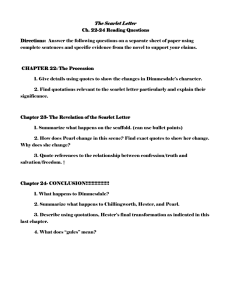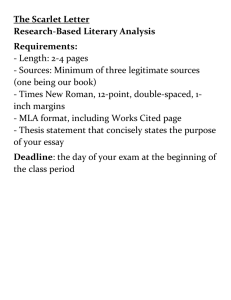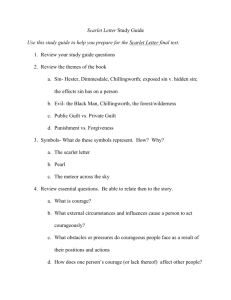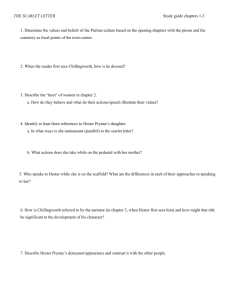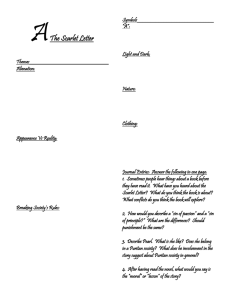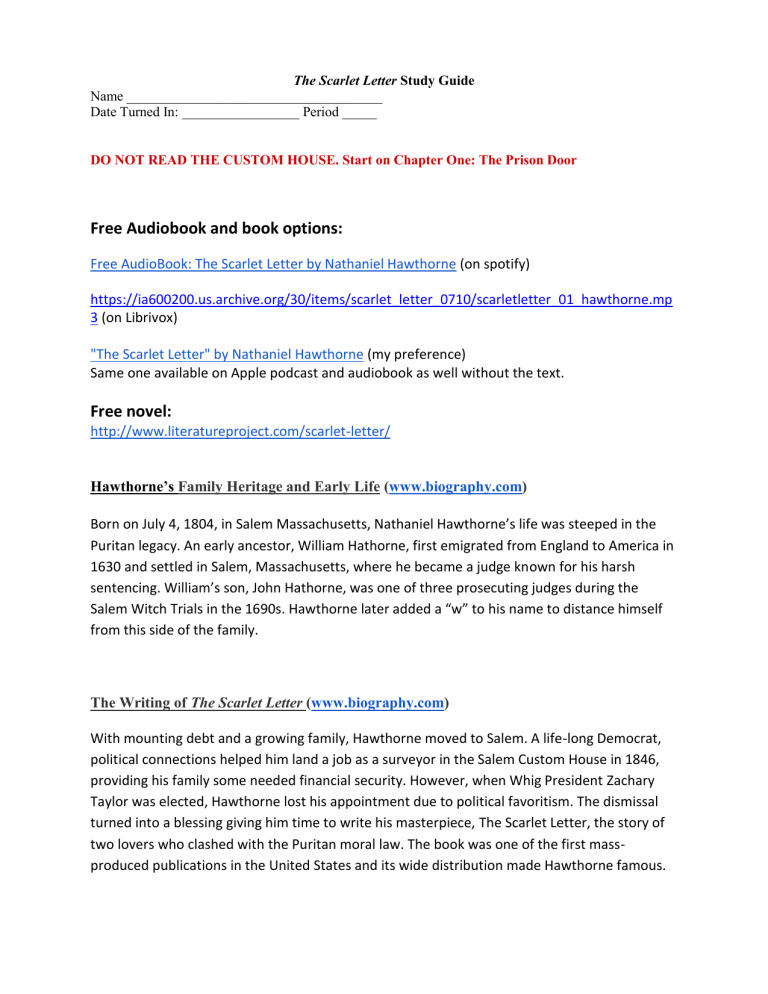
The Scarlet Letter Study Guide Name _____________________________________ Date Turned In: _________________ Period _____ DO NOT READ THE CUSTOM HOUSE. Start on Chapter One: The Prison Door Free Audiobook and book options: Free AudioBook: The Scarlet Letter by Nathaniel Hawthorne (on spotify) https://ia600200.us.archive.org/30/items/scarlet_letter_0710/scarletletter_01_hawthorne.mp 3 (on Librivox) "The Scarlet Letter" by Nathaniel Hawthorne (my preference) Same one available on Apple podcast and audiobook as well without the text. Free novel: http://www.literatureproject.com/scarlet-letter/ Hawthorne’s Family Heritage and Early Life (www.biography.com) Born on July 4, 1804, in Salem Massachusetts, Nathaniel Hawthorne’s life was steeped in the Puritan legacy. An early ancestor, William Hathorne, first emigrated from England to America in 1630 and settled in Salem, Massachusetts, where he became a judge known for his harsh sentencing. William’s son, John Hathorne, was one of three prosecuting judges during the Salem Witch Trials in the 1690s. Hawthorne later added a “w” to his name to distance himself from this side of the family. The Writing of The Scarlet Letter (www.biography.com) With mounting debt and a growing family, Hawthorne moved to Salem. A life-long Democrat, political connections helped him land a job as a surveyor in the Salem Custom House in 1846, providing his family some needed financial security. However, when Whig President Zachary Taylor was elected, Hawthorne lost his appointment due to political favoritism. The dismissal turned into a blessing giving him time to write his masterpiece, The Scarlet Letter, the story of two lovers who clashed with the Puritan moral law. The book was one of the first massproduced publications in the United States and its wide distribution made Hawthorne famous. Hawthorne’s Style - Romantic, Gothic, Allegory, Psychological Realism This novel can be classified under several genres, including Romantic, Gothic, and allegorical. Please read about these here from the University of Houston open source content. As you the novel, make connections to these concepts and expect a question on the Summer Reading test regarding these genres. Introduction to Romanticism Gothic v. Romanticsm Literary techniques Hawthorne’s style seems elaborate for most modern readers, but his style would have been quite palatable for readers in the Victorian Age (the novel was published in 1850). He employs rich imagery, symbols, and figurative language. These very techniques are why this novel makes a fantastic introduction to the AP Literature class. Psychological Realism Psychological realism (also known as psychological novels) is a particular literary method in which a piece of fiction focuses on the interior motives, psychological processes, and characters' mental narratives instead of simply telling a story. Psychological realism focuses on why something happens and not just the scenario that plays out. It focuses on the mental processes of the characters and often includes their inner thoughts and feelings along with their motives for behavior. Examples of authors who use psychological realism are Henry James, Arthur Millers, and Fyodor Dostoevsky. Hawthorne was ahead of the curve on this one. Summer Reading Assignment Below The Scarlet Letter SUMMER READING ASSIGNMENT: Please type this if at all possible (you can save it as a word document when you download it) and turn it into It’s Learning AP ENGLISH IV on the first day of class for next year. Look for the AP ENGLISH 4 course and upload to the Summer Reading Assignment. If for some reason we do not have access to It’s Learning, then wait for instructions in class the first day, but be prepared to upload it that day. Before You Read The Scarlet Letter Chapters 1–8 Setting a Purpose Read to find out what part shame plays in the punishments inflicted by colonial Boston’s penal code. BACKGROUND - Lack of Stereotyping One element of The Scarlet Letter that made this novel unique for its time was its lack of stereotyping. In literature a stereotype is a character who is not developed for his or her own personal traits but as a collection of traits and mannerisms that are shared by other people who are members of that group. For example, a stereotyped villain is evil and heartless. The hero or heroine pitted against that villain is often Portrayed as compassionate, strong, or good-looking. Most heroes have an unusually well-developed sense of right and wrong. Unlike other writers of his time, Hawthorne avoided stereotypical characters and shallow characterization. He fully developed his characters by examining what made them human. He moved boldly into areas that some readers of the time might have found shocking, such as guilt, adultery, and social judgment. Did You Know? Laws in colonial Massachusetts covered everything from swearing to excessive decoration on women’s caps to murder. Whipping, branding, and other forms of public humiliation were relatively common practices in the colonies. Hester Prynne’s punishment was mild by Puritan standards. Review this excerpt to get a better understanding of Puritan beliefs: An excerpt from *Every Day Life in the Massachusetts Bay Colony* by George Francis Dow, 1935. VOCABULARY PREVIEW edifice n. building ensue v. to take place afterward feign v. to pretend gesticulation n. expressive gesture ignominy n. deep humiliation; disgrace inauspicious adj. unfavorable panoply n. full suit of armor; impressive array tribunal n. court or meeting at which a trial is carried out Active Reading The Scarlet Letter Chapters 1–8 All four of the main characters are introduced in this first section of the novel. As you read, note the main qualities of each character. In each chart below, write adjectives that describe that character, based on Hawthorne’s characterization and supply evidence from the text. Adjective to describe Hester Prynne: 1. Courageous Based on the following textual support: page 11: She wouldn’t hold her baby over the letter to hide her shame. She faced the angry crowd. 2. page # Adjective to describe Arthur Dimmesdale: 1. Based on the following textual support: page 2. page Adjective to describe Roger Chillingworth: 1. Based on the following textual support: page 2. page Adjective to describe Pearl: 1. Based on the following textual support: page 2. page Responding to The Scarlet Letter Chapters 1–8 Analyzing Literature Recall and Interpret 1. What is Hester Prynne’s punishment? What do the Puritan magistrates hope to accomplish with this punishment? 2. Whom does Hester recognize in the crowd as she stands on the scaffold? Why does this discovery both confuse and frighten her? 3. How does Hester live after she is released from prison? What keeps her from leaving Boston? Evaluate and Connect - What is remarkable about the scarlet letter Hester makes? What is Hawthorne suggesting by having Hester make such a letter? Before You Read The Scarlet Letter Chapters 9-15 Setting a Purpose - Read to find out how Hester and other characters deal with their guilt. BACKGROUND Did You Know? In Chapter 15, Hester wonders if Roger Chillingworth will sink into the earth and whether “deadly nightshade” or “henbane” will flourish in that spot. Even three hundred years ago, people knew of the dangerous properties of the plants Hester mentions. Both the foliage and the berries of the many varieties of nightshade are poisonous, causing death if enough is eaten. Henbane is cultivated for its pharmaceutical qualities. The henbane leaves, however, contain drugs that are toxic and so require careful handling. Hester assumes that something truly evil—and deadly—will arise from Chillingworth’s resting place. Anne Hutchinson Even in a single-minded colony such as Massachusetts, there was occasional dissent. Governor Winthrop’s greatest challenger was a woman whose liberal ideas were popular for a time among Boston residents. Anne Hutchinson was born in Lincolnshire, England, in 1591. In 1634 she moved with her husband and family to Boston, Massachusetts. An outspoken woman, Hutchinson began holding meetings in her house, teaching her own concepts of God and religion. She opposed the Puritan concept of morality, which she considered to be unnecessarily legalistic. She also opposed the authority of the Boston clergy. As governor, Winthrop had Hutchinson tried for questioning the authority of the ministers. Hutchinson was banished from the colony. Six years later Hutchinson and all but one of her children were killed by Native Americans on Long Island Sound. Hutchinson had supporters, and her group of admirers later included Nathaniel Hawthorne, who refers to her as the “sainted Ann Hutchinson” in Chapter 1 of The Scarlet Letter. VOCABULARY PREVIEW abstruse adj. difficult to understand appellation n. identifying name or title deleterious adj. having an unexpected harmful effect importunate adj. troublesomely urgent latent adj. hidden propensity n. tendency propinquity n. nearness stigmatized adj. identified with disgrace torpid adj. sluggish; without motion Active Reading - The Scarlet Letter Chapters 9–15 Chapters 9 through 15 move the plot forward by examining each of the main characters in turn. Readers become more closely acquainted with each character by means of the narrator’s insight into his or her thoughts and actions. After you read each chapter, write a one- or two-sentence summary, focusing on what the narrator reveals about the character(s) who are focused on in the chapter. Using the model below as a guide, provide three summaries for each chapter. Chapter 9 1. Roger Chillingworth becomes the friend and personal physician of Arthur Dimmesdale, whose health continues to decline. Dimmesdale suspects no evil from Chillingworth, whose aspect turns from scholarly to scheming. 2. Chapter 10 1. 2. Chapter 11 1. 2. Chapter 12 1. 2. Chapter 13 1. 2. Chapter 14 1. 2. Chapter 15 1. 2. Responding to The Scarlet Letter, Chapters-9-15 Analyzing Literature Recall and Interpret 1. How does Roger Chillingworth’s appearance change? How does Hester interpret the changes she sees in Chillingworth? 2. How does Dimmesdale feel about his role as the much-respected minister in the community? Why doesn’t he thrive amidst these people who so admire him? 3. What causes Hester to decide to speak to Chillingworth after so many years? What does she hope to accomplish? Extending Your Response Each of the three main adult characters has a different kind of guilt, and each handles his or her guilt differently. Discuss the reasons that each character feels guilty and provide evidence in Chapters 9 through 15 that describe the characters’ guilt and how they bear it. Hester feels guilty because _____________________________________________________________________________________ _____________________________________________________________________________________ _____________________________________________________________________________________ Quoted passage that describes her guilt and how she bears it, found on page_____: _____________________________________________________________________________________ _____________________________________________________________________________________ _____________________________________________________________________________________ _____________________________________________________________________________________ ************************************* Dimmesdale feels guilty because _____________________________________________________________________________________ _____________________________________________________________________________________ _____________________________________________________________________________________ Quoted passage that describes his guilt and how he bears it, found on page_____: _____________________________________________________________________________________ _____________________________________________________________________________________ _____________________________________________________________________________________ _____________________________________________________________________________________ ************************************* Chillingworth feels guilty because _____________________________________________________________________________________ _____________________________________________________________________________________ _____________________________________________________________________________________ Quoted passage that describes his guilt and how he bears it, found on page_____: _____________________________________________________________________________________ _____________________________________________________________________________________ _____________________________________________________________________________________ _____________________________________________________________________________________ Before You Read The Scarlet Letter Chapters 16-24 Setting a Purpose Read to find out how Hester copes with the demands of her Puritan society. BACKGROUND Did You Know? Conflict is at the heart of plot. The conflict may be between people, between people and nature, or within a single person. Hawthorne skillfully employs several kinds of conflict in The Scarlet Letter. By doing so, he creates tension and adds depth and complexity to his characters. Colonial Government The government of Massachusetts was by no means a democracy. Rather, it was a theocracy—a state governed by its church. The General Court had decided, early on, that only church members could become freemen of Massachusetts. That is, only church members could take part in the government of the colony. The ministers—the officials of the church—were not actually political leaders, but they held great power and influence over all church members. Ministers’ interpretation of the Bible and their “management” of moral codes and conduct applied to all residents of the colony, whether a lowly freeman or the governor himself. In spite of the rigidity of the social and political structure, government in colonial Massachusetts did adapt to the people’s requirements. At first, the governor, deputy-governor, and other officers held their elected positions for life. The freemen, however, wanting more say in choosing their leaders, eventually had elected positions changed to annual appointments. Thus, by the mid-1600s, the annual election day, as observed in The Scarlet Letter, had become an established event. VOCABULARY PREVIEW colloquy n. formal conversation or discussion contiguous n. next to; touching indefatigable adj. untiring inducements n. motives; incentives loquacity n. the habit of talking continually or excessively obeisance n. gesture of respect probity n. honesty; uprightness recompense n. payment for a service vicissitude n. quality of being changeable Responding to The Scarlet Letter Chapters 16–24 Recall and Interpret 1. Why does Hester plan to speak to Dimmesdale? What is the result of the meeting? 2. Who else approaches Dimmesdale just as he invites Pearl and Hester to join him near the scaffold? Why does this person wish to prevent Dimmesdale from mounting the scaffold? 3. What happens to Chillingworth after Dimmesdale dies? Why do you think this happens? Evaluate and Connect 4. In your opinion, what effect does Pearl have on Dimmesdale? What role, if any, does she play in bringing about his confession? What role does she play as a symbol? 5. The wearing of the scarlet letter was intended to isolate Hester Prynne from society and to call attention to her sin. Given the way in which Hester’s life ends, do you think that the scarlet letter accomplished what the magistrates intended? Explain. A Final Response to The Scarlet Letter 1) Is Arthur Dimmesdale a remarkably strong character to have carried his burden of guilt for so many years? Or was he weak for not having the courage to confess? Given what we know about him, would he have been able to “run away” with Hester and Pearl and start a new life? Cite evidence from the text to support your opinions. (Short paragraph) 2) Some readers of The Scarlet Letter feel that Hester Prynne was successfully repressed, or restricted, by her Puritan society. Others feel that, in spite of her public disgrace and punishment, she was able to express herself in meaningful ways. What is your opinion? Cite evidence from the novel to support your thoughts as you write a persuasive argument. (Short essay/longer paragraph)


